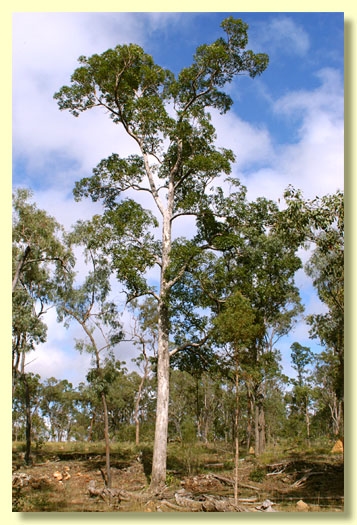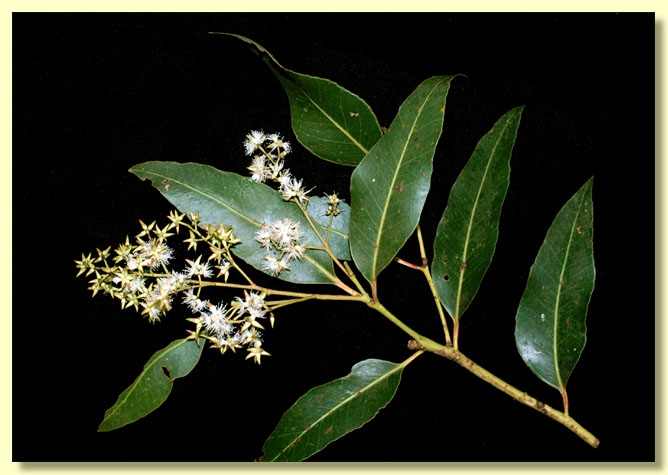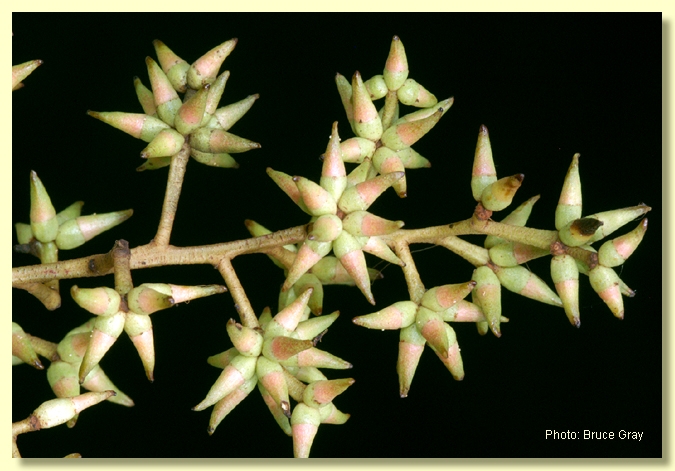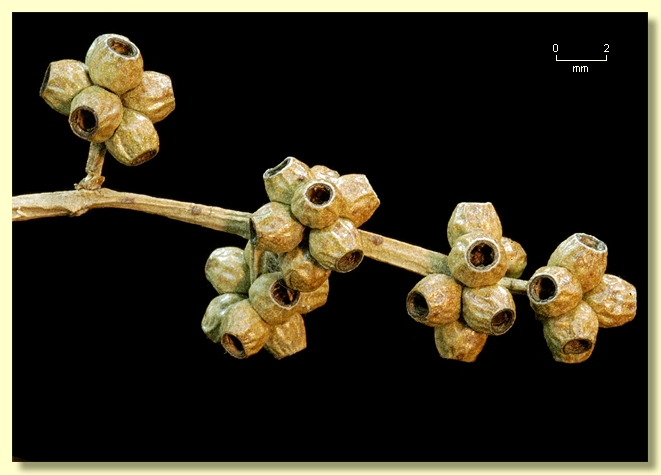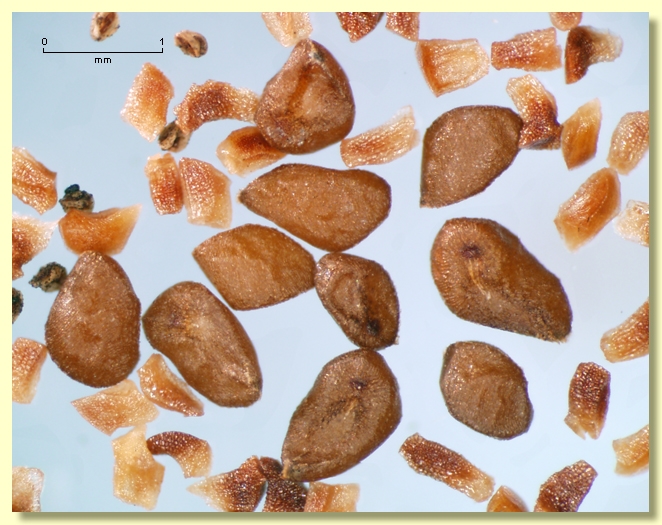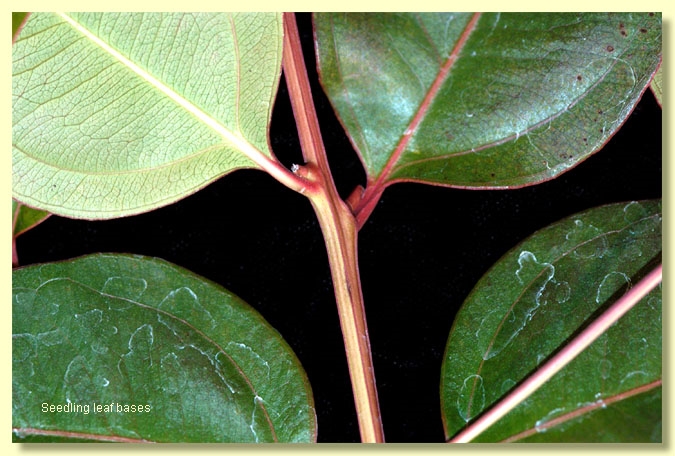Euclid - Online edition
Eucalyptus howittiana
Eucalyptus | Minutifructus | Domesticae
Tree to 25 m tall. Forming a lignotuber.
Bark rough to branches ca 2 cm diameter, shortly fibrous and flaky box-type, often fissured, becoming tessellated on some older trunks, grey.
Branchlets lack oil glands in the pith.
Juvenile growth (coppice or field seedlings to 50 cm) : stems square in cross-section, smooth; juvenile leaves petiolate, sub-opposite to alternate, deltoid to ovate, 7–14 cm long, 3–7.5 cm wide, base truncate to rounded, apex pointed or rarely rounded, margin often crenulate and with dark granulations, apex pointed, green, discolorous.
Adult leaves alternate, petioles 1–2.1 cm long; blade lanceolate to ovate, 7–13 cm long, 1.6–4.2 cm wide, base tapering to the petiole or oblique, margin entire or crenulate and with blackish granulations on margin, apex pointed often with a drip-tip, discolorous, glossy, green, thick-textured, side-veins at greater than 45° to the midrib, reticulation dense, intramarginal vein present but at times very close to margin, oil glands usually obscure but some small island and intersectional glands may be visible.
Inflorescence terminal compound, peduncles 0.2–0.6 cm long, buds arranged in umbels of ?7 to 11 but sometimes one bud is replaced by another peduncle bearing another umbel so the arrangement is often unclear, pedicels absent. Mature buds fusiform, 0.5–0.6 cm long, 0.15–0.2 cm wide, yellow, sepals formed but usually not seen as they fall very early in development, operculum scar therefore absent, inner operculum conical and longer than the hypanthium, stamens irregularly flexed, anthers oblong to reniform, versatile, dorsifixed, dehiscing by longitudinal slits, style long and straight, stigma blunt, locules 3, the placentae each with 4 vertical rows of ovules. Flowers white-cream.
Fruit sessile, truncate-globose to barrel-shaped, 0.2–0.3 cm long, 0.2–0.3 cm wide and long, disc descending (hidden), valves 3, enclosed.
Seeds brown, 0.7–1 mm long, ± flattened ovoid, smooth, hilum ventral.
Cultivated seedlings (measured at ca node 10): cotyledons bilobed; stems square in cross-section, smooth; leaves opposite for 12 or more pairs, petiolate, lowest leaves linear-elliptic becoming elliptic-lanceolate then lanceolate, 3–5.5 cm long, 1–2 cm wide, base tapering to petiole, margin entire or crenulate, apex acute, green.
Flowering has been recorded in January and May.
A tree with very restricted distribution in hill country in tropical sub-coastal north-eastern Queensland. Eucalyptus howittiana is found on rocky hillslopes and escarpments on a variety of substrates but always on well-drained, usually skeletal soils, in woodlands with other eucalypts or on the edge of semi-deciduous vine thicket. E. howittiana is distinctive because of its profuse terminal inflorescences of very small sessile fusiform buds (ca 0.1 cm wide and <0.6 cm long), small isodiametric fruit to 0.3 cm wide and long, thickish discolorous crown leaves and extensive rough box-type bark. The buds and fruit alone distinguish it from all other eucalypts in Queensland.
In the classification of Brooker (2000) Eucalyptus howittiana is placed in Eucalyptus subgenus Minutifructus. There are only four species in this subgenus, all tropical, sharing the characteristics of terminal compound inflorescences, discolorous leaves with dense reticulation and small buds with outer sepals (or operculum) lost very early, an inner petaline operculum that persists until flowering, and tiny fruit. The other three species are E. brachyandra, a species from tropical north-western Australia with small ovate-elliptic leaves, full finely fibrous/stringy bark and sandstone escarpment habitat; E. raveretiana, a partly rough-barked tree with long broadly lanceolate leaves, endemic to north-east Queensland and found on alluvial soils along streams; and the extra-Australian tropical tree species, E. deglupta, which has smooth bark and opposite ovate leaves, and forms pure stands on river flats. Eucalyptus deglupta is sporadically distributed from New Britain through Papua New Guinea; West Papua, Celebes, and Ceram in Indonesia; and Mindanao in the Philippines.
Eucalyptus howittiana: named in honour of Alfred William Howitt (1830–1908). Alfred Howitt was a bushman, explorer, botanist, geologist, anthropologist, magistrate and public servant. He was born in England and came to Victoria, Australia in 1852 where he lived for the rest of his very active life.

